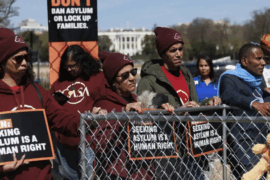HIV infection rates have increased for Latinxs in recent years, causing sufficient alarm in the health community for the issue to be labeled an “invisible crisis.” While Latinxs represented almost 18% of the entire U.S. population in 2017, they accounted for 26% of the nearly 40,000 new HIV diagnoses in the country, a study by the New York University’s Center for Latino Adolescent and Family Health and the Latino Commission on AIDS found.
“Persistent HIV disparities among U.S. Hispanics/Latinos represent a significant challenge to national goals for ending the HIV epidemic by 2030,” the report states. In contrast, New York Gov. Andrew M. Cuomo had expressed confidence the AIDS epidemic would end in 2020 amid reports of an overall decrease in HIV infection rates.
The report’s breakdown looked at annual HIV diagnoses from 2012 to 2016, noting an increase of 14% in new infections among Latinxs during this time period. In contrast, new infections among the U.S. overall went down by 6% in that same time period, while new infections saw about a 3% and 1% decrease among Whites and Blacks, respectively.
An accompanying infographic, #InvisibleCrisis, called the rate of HIV/AIDS among Latinxs “alaming” and said it affects specific subpopulations, including gay men, who account for 8 in 10 new HIV infections among Latinxs.
One in 4 Latina transgender females in the U.S. is believed to be living with HIV. One in 3 Latinxs who are newly diagnosed with HIV was born outside of the continental U.S. However, the majority “acquired” HIV in the U.S.
The so-called “HIV epidemic” is concentrated in California, Arizona, Texas, Florida, New York, Illinois and Puerto Rico. There are also other areas in the country with high numbers of Latinxs with HIV infections.
Tools for HIV prevention and treatment “are not adequately reaching” Latinxs who most need them, the infographic states. For example, more than half of Latinxs have never been tested for HIV, and 1 in 6 Latinxs with HIV are unaware of their status.
Latinxs account for 1 in 4 new HIV infections, but only 1 in 8 take medication to lower their chances of infection, according to the report, . For every 5 Latinxs that are living with HIV, only 2 receive HIV care.
It is vital to address this issue, given that Latinxs are the largest and youngest ethnic group in the country, the infographic notes. There are more than 100 health and social organizations nationwide building a “community consensus process” to address the issue. The efforts include stigma reduction, increasing availability and accessibility of HIV prevention and treatment for Latinxs in need, increasing Latinx-specific research and targeted funding, and engaging the Latinx community to increase national public health efforts.
Others have already been working to address the issue, including Latina researcher Patria Rojas, who arms Latinas in Florida farmworker communities with knowledge about their bodies, sex and how to use a female condom. “I did this study because these women are at higher risk than women who have more education, live in communities where there is less HIV, and more access to treatment and health care,” Patria told NBC News.
Latinas who participated in the program were asked to examine their own bodies as homework. They learned about HIV and how it’s transmitted. Then, they had to practice using a female condom at home, which can be placed in the body hours before sexual intercourse.
By the end of Patria’s study, the women were three times more likely to use condoms. Single women, specifically, were four times more likely to use them.




